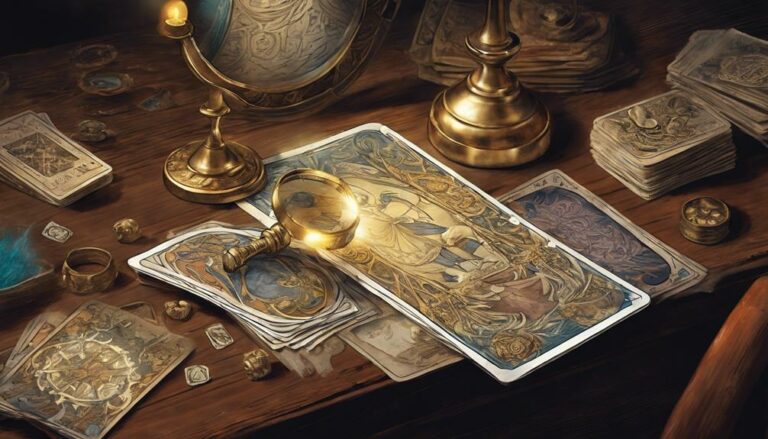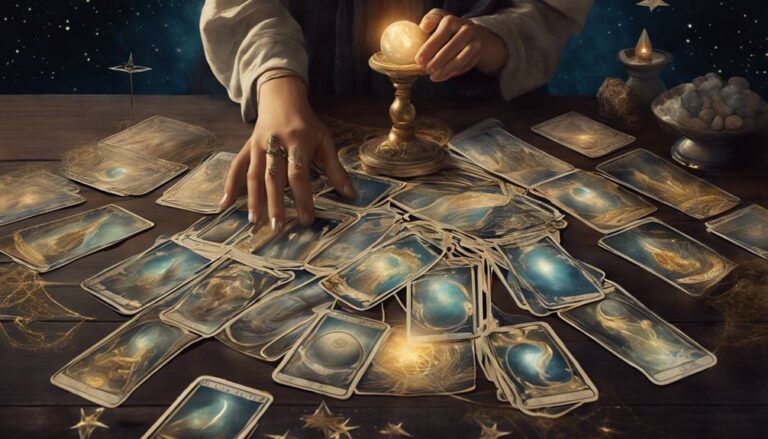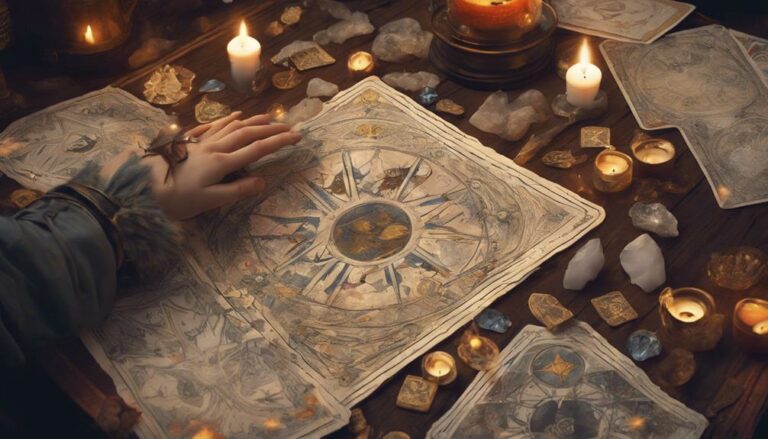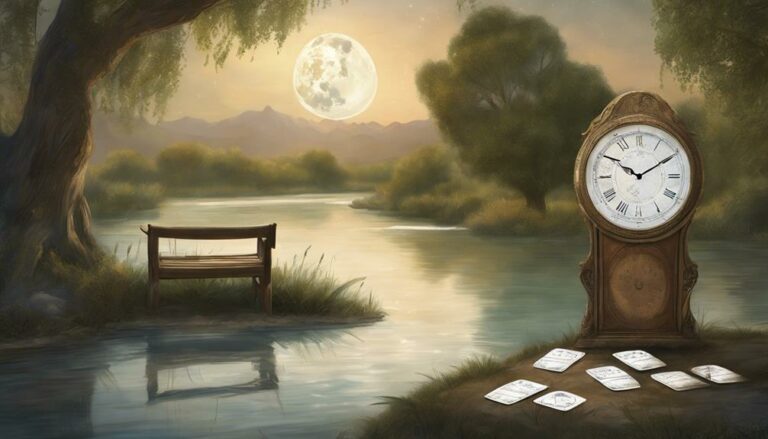I’ve always been fascinated by the intricate symbolism woven into classic works. And what better way to explore this symbolism than through the enigmatic world of tarot cards? In this article, we’ll delve into the intriguing connections between tarot card imagery and classic literature. From the Fool’s journey to the transformative power of the Death card, we’ll uncover the hidden meanings and deeper layers behind these timeless tales. So grab your deck and join me on this insightful journey into the realm of tarot card symbolism in classic literature.
Table of Contents
ToggleKey Takeaways
- Tarot card symbolism is prevalent in many classic works of literature.
- Authors use tarot card symbolism to add depth and intrigue to characters.
- Tarot card symbolism explores themes of transformation and the inevitability of change.
- Tarot card symbolism reflects the unpredictable nature of fate and the cyclical patterns of life.

The Fool Card in Classic Literature
The Fool card’s symbolism is prevalent in many classic works of literature. One notable example is its role in Shakespearean plays. In these plays, the Fool is often a jester or clown who provides comic relief and acts as a truth-teller. The Fool card represents a sense of innocence, spontaneity, and freedom. In Shakespeare’s “King Lear,” for instance, the Fool serves as a voice of reason and insight, offering wisdom to the misguided King. This symbolic interpretation of the Fool card reflects the idea that wisdom can come from unexpected sources and that appearances can be deceiving.
Another genre where the Fool card’s symbolism is commonly found is Gothic novels. In these dark and mysterious tales, the Fool represents the uncanny, the irrational, and the supernatural. The Fool is often portrayed as a madman or a trickster, challenging the boundaries of reason and sanity. In novels like Mary Shelley’s “Frankenstein” or Bram Stoker’s “Dracula,” the Fool card represents the chaotic and unpredictable forces that threaten the stability of the world. It serves as a reminder that even in the most rational and ordered societies, there is always an element of madness lurking beneath the surface.
Overall, the Fool card’s symbolism in classic literature showcases its versatility and depth. Whether it is used to provide comic relief or explore the darker aspects of human nature, the Fool card continues to captivate readers with its enigmatic presence.
The Magician Card in Classic Literature
Explore how authors of the past have utilized the captivating energy of The Magician in their stories to add depth and intrigue to their characters. The symbolism of the Magician card in Shakespearean plays is evident in the character of Prospero in “The Tempest”. Like the Magician, Prospero possesses great power and knowledge, using his abilities to manipulate the events on the island. His transformation from a vengeful sorcerer to a wise and forgiving ruler showcases the transformative power of the Magician card.
In Jane Austen novels, the Magician card symbolizes the transformative power of love. In “Pride and Prejudice”, the character of Mr. Darcy undergoes a significant transformation under the influence of Elizabeth Bennet, much like the Magician card represents the ability to harness one’s inner power and make positive changes. Through their interactions and the lessons they learn from each other, both characters are able to grow and evolve.
Overall, the use of the Magician card in classic literature adds depth and intrigue to characters by exploring themes of power, transformation, and personal growth. It serves as a symbol of the potential within individuals to change their circumstances and shape their own destinies.

The High Priestess Card in Classic Literature
Step into the world of classic literature and discover how authors have harnessed the mystical energy of the High Priestess to add depth and intrigue to their stories. The portrayal of the High Priestess card in classic literature has often been used as a symbol of female empowerment, highlighting the strength and wisdom of women in a male-dominated society.
Female Empowerment in Classic Literature through the portrayal of the High Priestess card:
- The High Priestess is often depicted as a wise and mysterious figure, representing the power of female intuition and knowledge.
- In classic literature, female characters who embody the qualities of the High Priestess are portrayed as strong, independent, and capable of making their own decisions.
- Through the High Priestess card, classic literature challenges traditional gender roles and empowers women to take control of their own destinies.
Exploring the Mysterious and Intuitive Qualities of the High Priestess card in Classic Literature:
- The High Priestess is often associated with secrets, hidden knowledge, and the subconscious mind.
- In classic literature, the High Priestess card is used to explore themes of mystery, intuition, and the supernatural.
- Through the portrayal of the High Priestess, authors create an aura of intrigue and suspense, drawing readers into a world of hidden truths and enigmatic characters.
The Death Card in Classic Literature
Get ready to delve into the intriguing portrayal of the Death card in classic literature, where authors use this powerful symbol to explore themes of transformation and the inevitability of change. The role of the death card in character development and plot twists is significant, as it often represents a pivotal moment in a character’s journey. In classic literature, the death card is not merely a symbol of physical death, but rather a metaphorical death or transformation that leads to personal growth and revelation.
One symbolic interpretation of the death card in classic literature is its representation of the cycle of life and rebirth. Just as the card depicts a skeleton reaping the harvest, authors use this imagery to explore the idea that death is not an end, but rather a necessary part of the natural order. Characters who encounter the death card often undergo profound changes, shedding their old selves and embracing a new identity.
Another interpretation of the death card in classic literature is its association with the inevitability of change. The card serves as a reminder that everything in life is transient and subject to transformation. When characters encounter the death card, it often signifies a turning point in the plot, where they must confront their fears, let go of the past, and adapt to new circumstances.

The Wheel of Fortune Card in Classic Literature
As you dive into classic literature, you’ll encounter the Wheel of Fortune card, a potent symbol that reflects the unpredictable nature of fate and the cyclical patterns of life. In classic literary works, the portrayal of the Wheel of Fortune card plays a significant role in exploring the role of fate and its impact on characters’ lives.
Here are three sub-lists that highlight the symbolic significance of the Wheel of Fortune card in character development in classic literary works:
Representation of Fate:
- The Wheel of Fortune card often symbolizes the role of fate in determining the trajectory of characters’ lives.
- It emphasizes the idea that no matter how much control individuals believe they have, ultimately, fate has the final say.
- The card serves as a reminder that life is full of ups and downs, reflecting the cyclical nature of human existence.
Lessons in Humility:
- The Wheel of Fortune card humbles characters, reminding them that their fortunes can change in an instant.
- It teaches characters to be prepared for unexpected twists and turns in life, fostering personal growth and resilience.
- Through the card’s symbolism, characters learn to accept their lack of control and find meaning in the face of adversity.
Transformation and Redemption:
- The Wheel of Fortune card often signifies turning points in characters’ lives, leading to transformative journeys.
- It presents opportunities for characters to change their circumstances and seek redemption for past actions.
- The card’s symbolism highlights the potential for personal growth and the possibility of breaking free from the cycle of fate.
Frequently Asked Questions
How Does the Fool Card in Classic Literature Represent Innocence and Spontaneity?
In classic literature, the fool card represents innocence and spontaneity. It serves as a symbol of carefree naivety and unfiltered truth. The fool’s presence adds depth to the narrative, offering insights into characters and their actions.
What Are Some Examples of Classic Literary Works Where the Magician Card Symbolizes the Power of Transformation and Manipulation?
In classic literature, the magician card serves as a powerful symbol of transformation and manipulation. It plays a significant role in character development and adds depth to the overall narrative.
Can You Provide Examples of How the High Priestess Card in Classic Literature Represents Intuition and Hidden Knowledge?
In classic literature, the high priestess card represents intuition and hidden knowledge. Examples of this can be seen in characters who possess a deep understanding of the world around them and use their insights to navigate complex situations. Tarot card symbolism plays a vital role in character development.
How Is the Death Card Portrayed in Classic Literature, and What Does It Symbolize in Terms of Transformation and New Beginnings?
In classic literature, the death card is depicted as a profound transformation, like a phoenix rising from the ashes. It symbolizes the end of one phase and the beginning of another, bringing new opportunities and growth.
In Classic Literary Works, How Is the Wheel of Fortune Card Depicted and What Does It Symbolize in Terms of Destiny and Unexpected Changes?
In classic literature, the depiction of the Wheel of Fortune card varies, but it generally symbolizes destiny and unexpected changes. It represents the idea that life is a cycle of ups and downs, where fortunes can shift unexpectedly.
Conclusion
As I reflect on the tarot card symbolism in classic literature, a profound realization washes over me like a gentle tide. These cards, with their intricate imagery and deep meaning, serve as windows into the human psyche. They offer us a glimpse into the universal truths and archetypes that transcend time and culture. Like a skilled magician, classic literature employs these cards to weave tales of transformation, knowledge, and destiny. The tarot cards, like the pieces of a grand puzzle, fit seamlessly into the tapestry of classic literature, adding depth and symbolism to the already rich narratives. Just as the Death card represents the end of one chapter and the beginning of another, so too does classic literature invite us to embrace change and growth. Through the Wheel of Fortune card, we are reminded of the ever-turning wheel of fate and the unpredictable nature of life. With each card, classic literature unveils a piece of the human experience, inviting us to explore the depths of our own souls. In this vast sea of symbolism, we find solace and insight, allowing us to navigate the turbulent waters of existence with grace and understanding.










